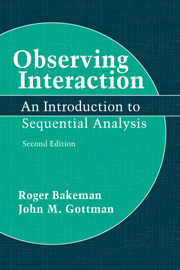Book contents
- Frontmatter
- Contents
- Preface to the second edition
- Preface to the first edition
- 1 Introduction
- 2 Developing a coding scheme
- 3 Recording behavioral sequences
- 4 Assessing observer agreement
- 5 Representing observational data
- 6 Analyzing sequential data: First steps
- 7 Analyzing event sequences
- 8 Issues in sequential analysis
- 9 Analyzing time sequences
- 10 Analyzing cross-classified events
- 11 Epilogue
- Appendix: A Pascal program to compute kappa and weighted kappa
- References
- Index
Preface to the second edition
Published online by Cambridge University Press: 13 October 2009
- Frontmatter
- Contents
- Preface to the second edition
- Preface to the first edition
- 1 Introduction
- 2 Developing a coding scheme
- 3 Recording behavioral sequences
- 4 Assessing observer agreement
- 5 Representing observational data
- 6 Analyzing sequential data: First steps
- 7 Analyzing event sequences
- 8 Issues in sequential analysis
- 9 Analyzing time sequences
- 10 Analyzing cross-classified events
- 11 Epilogue
- Appendix: A Pascal program to compute kappa and weighted kappa
- References
- Index
Summary
Since the first edition of Observing Interaction appeared in 1986, the technology supporting recording and systematic coding of behavior has become less expensive, more reliable, and considerably less exotic (Bakeman, in press; revised chapter 3, this volume). Cumbersome videotape and cassette recorders have given way to video camcorders. Visual time codes are routinely recorded as part of the picture, and equipment to write and read machine-readable time codes is readily available at reasonable cost. Increasingly, computers assist coding, making routine what once was labor intensive and time-consuming. Even physiological recording devices can be added to the computer's net (Gottman & Bakeman, in press). Thus an increasing circle of investigators can avail themselves of the methods detailed in this book without mortgaging their careers, their lives, or the lives of their associates.
At the same time, the way we think about sequential data has developed. This is reflected in a standard format for sequential data (Bakeman & Quera, 1992, 1995a; revised chapter 5, this volume). SDIS – the Sequential Data Interchange Standard – has greatly facilitated the analysis of sequential data. Again, an enterprise that formerly was time-consuming and cumbersome has yielded to appropriately designed computer tools, as described in my and Quera's Analyzing Interaction (1995), which should be regarded as a companion to this volume. This revised version of Observing Interaction still explains how to conceptualize, code, record, organize, and analyze sequential data, but now Analyzing Interaction provides the tools to do so easily.
- Type
- Chapter
- Information
- Observing InteractionAn Introduction to Sequential Analysis, pp. ix - xPublisher: Cambridge University PressPrint publication year: 1997



